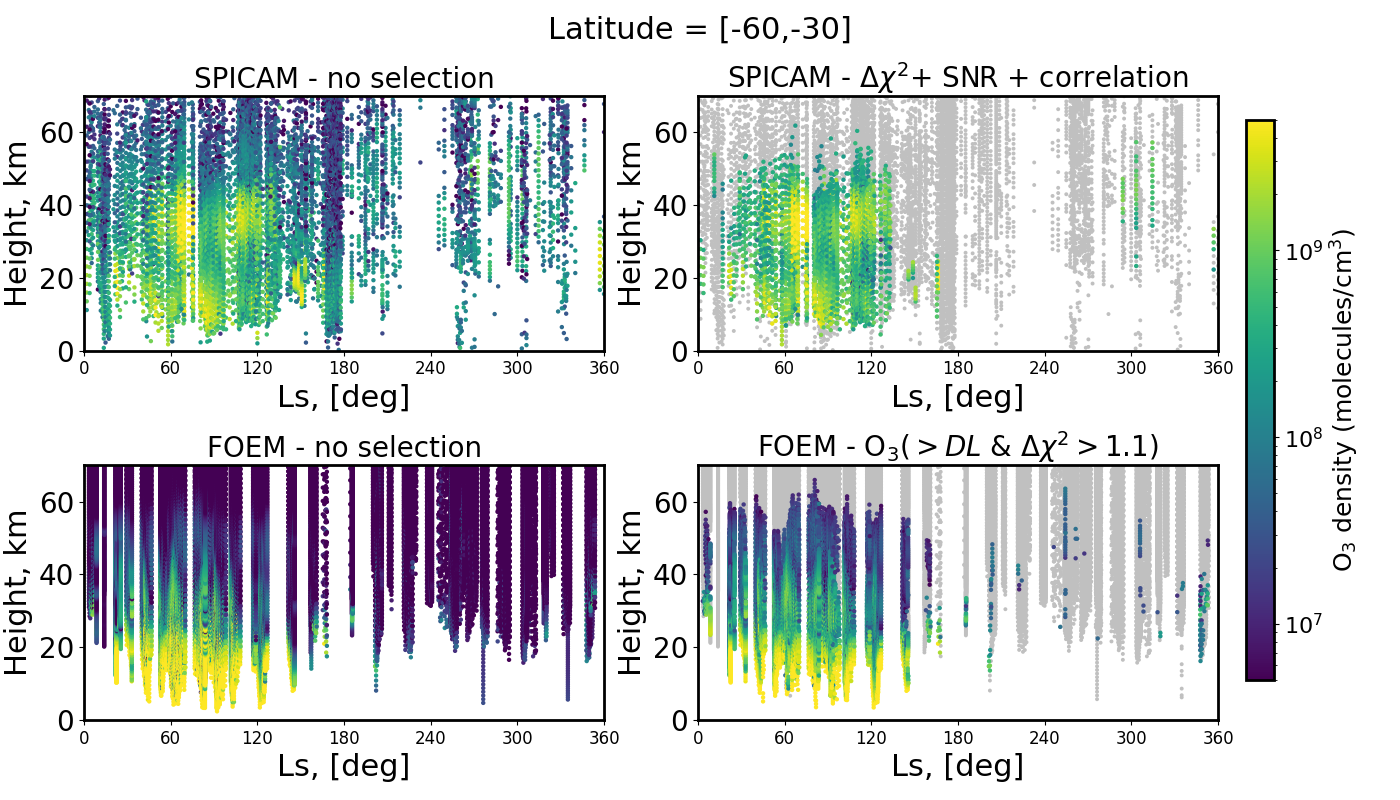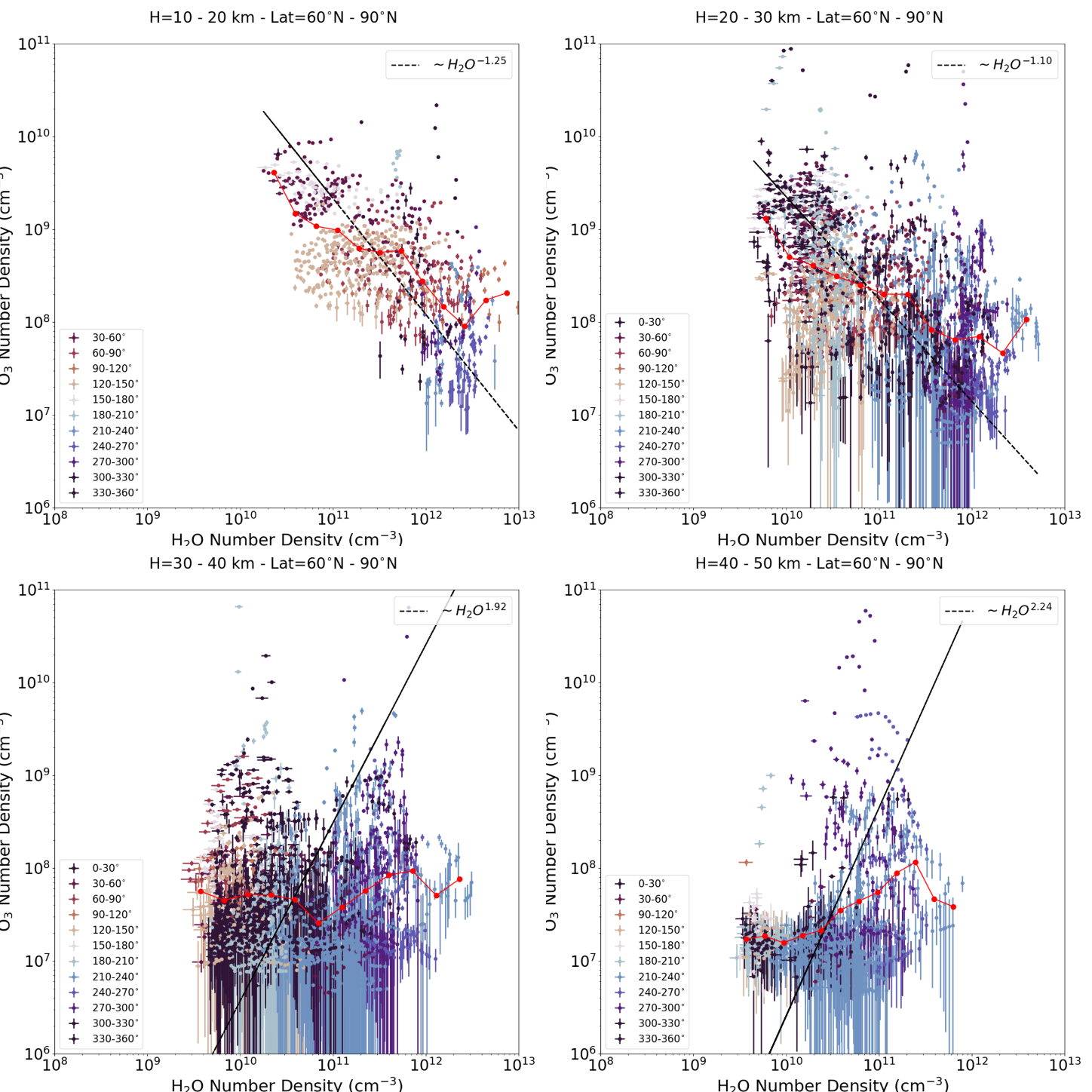- 1Royal Belgian Institute for Space Aeronomy, Belgium
- 2LATMOS/IPSL, Sorbonne Université, UVSQ, CNRS, Paris, France
- 3Graduate School of Frontier Sciences, The University of Tokyo, Kashiwa, Japan
- 4School of Physical Sciences, The Open University, Milton Keynes, U.K.
- 5Space Science Institute, Boulder, CO, USA
- 6NASA Goddard Space Flight Center, Greenbelt, MD 20771, USA
- 7Center for Research and Exploration in Space Science and Technology II, University of Maryland, USA
- 8Istituto di Astrofisica e Planetologia Spaziali, IAPS-INAF, Rome, Italy
- 9Instituto de Astrofisica de Andalucia, IAA-CSIC, Granada, Spain.
Introduction: The NOMAD-UVIS instrument on board the ExoMars Trace Gas Orbiter has been investigating the Martian atmosphere with the occultation technique since April 2018 [1]. In the solar occultation mode, it is mainly devoted to studying the climatology of ozone and aerosols content [2,3,4].
We analyzed almost two Mars Years of ozone vertical distributions acquired at the day-night terminator, corresponding to more than 8300 solar occultations, acquired between April 2018 (MY 34, LS=163°) and November 2021 (MY 36, LS=132°).
Retrieval method(s): As in the work of [5], the NOMAD-UVIS ozone retrievals proved more difficult than expected due to the presence of spurious detections of ozone caused by instrumental effects, high dust content, and very low values of ozone. This led us to compare the results from three different retrieval approaches:
- an onion peeling method (OP);
- a full occultation Optimal Estimation Method (FOEM), and
- a direct onion peeling method (DOP).
The OP method is similar to that used for Mars and Venus stellar occultations [6,7]. The FOEM and DOP approaches are based on ASIMUT-ALVL, the BIRA-IASB radiative code [8,9].
The main challenge was to find reliable criteria to exclude spurious detections of O3, and we finally adopted two criteria for filtering: i) a detection limit, and ii) the Δχ2 criterion. Both criteria exclude spurious O3 values especially near the perihelion, where based on the simulations from a general circulation model, we do expect very low values of ozone.
Comparison of filtering methods between UVIS and SPICAM:
We compared the results of filtering with SPICAM-UVIS observations. The SPICAM team applied very similar criteria for filtering their data to the ones implemented here [5]. Even if the two instruments observed during different Martian Years, the agreement on the filtered O3 retrievals is very good, and both filtering approaches lead to very similar results (see Figure 1).

Figure 1: An example of the effect of the selection criteria for SPICAM-UV and NOMAD-UVIS obser-vations for a latitude band (-60°;-30°). Left panels show the ozone vertical distribution before applying the filtering; right panels shows O3 profiles after the selection criteria.
The O3-H2O relationship: Water vapor was observed by the infrared channel of the NOMAD SO. The results from a first analysis can be found in [10], while an extended dataset is presented in a companion abstract [11]. Water vapor and ozone are measured simultaneously, which allows us to investigate the water-ozone correlation, the key to addressing the atmospheric chemistry on Mars.
We present correlation plots of O3 vs. H2O at high latitudes (60°-90°, both hemispheres), and at the equator (30°S-30°N). It is important to notice that during a solar occultation experiment at the terminator, ozone may exhibit rapid changes due to photolysis that are uncorrelated to water vapor. As an example, we show the 60°N-90°N latitude region (Figure 2): a clear anti-correlation is observed at lower altitudes, up to 40 km. O3 is roughly proportional to (H2O)-1.0 up to 30 km and a variation with Ls seems also present.

Figure 2: O3 (cm-3) vs. H2O (cm-3) vertical profiles measured simultaneously by NOMAD-UVIS at high latitudes in the Northern hemisphere (60°N-90°N). (a) 10 – 20 km; (b) 20 – 30 km; (c) 30 – 40 km; (d) 40 – 50 km. Colours indicate the Ls interval. The black line shows the function O3 =H2Ox, with x varying with the altitude range.
Impact of gradients at the Martian terminator: Rapid variations in species concentration at the terminator have the potential to cause asymmetries in the species distributions along the line of sight (LOS) of a solar occultation experiment. Ozone, in particular, displays steep gradients across the terminator of Mars due to photolysis [12]. Nowadays, most of the retrieval algorithms for solar and stellar occultations rely on the assumption of a spherically symmetrical atmosphere. However, photochemically induced variations near sunrise/sunset conditions need to be taken into account in the retrieval process in order to prevent inaccuracies.
We investigated the impact of gradients along the LOS for the retrieval of ozone under sunrise/sunset conditions. We used the diurnal variations in the ozone concentration obtained from photochemical model calculations together with an adapted radiative transfer code.
References: [1] Vandaele et al. (2015), PSS. [2] Patel et al. (2021), JGR (Planets). [3] Khayat et al. (2021), JGR (Planets). [4] Neefs, E., et al. (2015) Applied Optics. [5] Määttänen et al. Icarus, in review. [6] Quémerais et al. (2006), JGR (Planets). [7] Piccialli et al. (2015), PSS. [8] Vandaele et al., (2008), JGR (Planets). [9] Piccialli et al. (2021), Icarus. [10] Aoki et al. (2019), JGR (Planets). [11] Aoki et al., (2021) EPSC. [12] Lefèvre, et al. (2008), Nature.
How to cite: Piccialli, A., Vandaele, A. C., Willame, Y., Määttänen, A., Trompet, L., Erwin, J., Daerden, F., Neary, L., Aoki, S., Viscardy, S., Thomas, I., Depiesse, C., Ristic, B., Mason, J., Patel, M., Wolff, M., Khayat, A., Bellucci, G., and Lopez-Moreno, J. J.: Ozone in the Martian atmosphere observed by TGO/NOMAD-UVIS solar occultations, Europlanet Science Congress 2022, Granada, Spain, 18–23 Sep 2022, EPSC2022-1027, https://doi.org/10.5194/epsc2022-1027, 2022.

